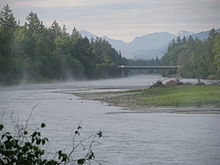Marienbrücke (Wolfratshausen)
The Marienbrücke is a road bridge for motor vehicles, cyclists and pedestrians near Wolfratshausen in Upper Bavaria. The 142 meter long structure spans the Isar at the level of the Pupplinger Au and connects the city of Wolfratshausen with the municipality of Egling . State road 2070 runs over the bridge , coming from Starnberg via Wolfratshausen to Sauerlach and representing an important connection between the Munich – Garmisch-Partenkirchen (A 95) and Munich – Salzburg (A 8) motorways south of the state capital.
Bridge renovation from 1990
In 1990 the Marienbrücke was completely renewed. The costs amounted to 4.3 million euros. A sculpture of the bridge saint Maria was also commissioned. This was made by the sculptor Anton Ferstl from Penzberg and erected on the new bridge in December 1990, where it was ceremoniously consecrated together with the bridge structure by Wolfratshausen Pastor Ulrich Wimmer shortly before Christmas. The then Bavarian Interior Minister Edmund Stoiber , himself a resident of Wolfratshausen, was also present.
Controversy about the bridge figure
Several local politicians and art experts had voted in a selection committee for the Penzberg artist's “Maria with Child” design. He created a bronze sculpture of a confident young woman with a lively toddler.
But there were soon numerous and violent protests against the sculpture on the part of conservative Catholics due to the unusual portrayal of Mary, in the course of which the figure of Mary was defamed as “whore” and “beach chick” and the artist was insulted. The baby Jesus did not please either and was described as a “terrible freak”. Devout believers demanded the "fastest possible desecration" of this "indescribable blasphemy". The consecrating pastor, who would have wished for the sculpture to be “a little different, more devout, more sacred”, was surprised by the extent of the protests and exposed to hostility. Signatures were collected, Interior Minister Stoiber and Prime Minister Max Streibl were asked to intervene. But the Archbishop's Ordinariate found that there was no reason to remove the figure. There were numerous proponents of the Bridge Madonna who saw the figure as an "artistically sophisticated modern sculpture" that "fits our time". Candles and flowers were set up. The dispute was widely reported in national media including television.
The controversy came to a head when the figure suddenly disappeared overnight. It turned out that it had been dismantled and thrown over the railing into the Isar. It was damaged in the process. It was given to the sculptor for restoration. In the meantime, it was agreed that the statue of Mary should not be placed prominently in a niche in the pedestrian area in the middle of the bridge, but a little off the western bridge approach, on the orographic left bank of the river between the access to the raft landing and the state road ▼ . The sculpture has stood there undisturbed for years.
The events surrounding the damage to the figure are mentioned in Gerhard Polt's monologue "1705" .
Surroundings
The Wolfratshauser Floßlände is located directly north of the bridge on the western side of the Isar , from where the excursion rafts leave for Munich in summer .
To the south of the Marienbrücke, the level Puppling of the Isar is determined.
Web links
References
- Maria as a beach chick Article in Die Zeit , No. 12 of March 15, 1991
- Removal of the new figure of Mary required. In: Bad Tölz-Wolfratshauser Latest news from January 11, 1991, page I.
Coordinates: 47 ° 55 ′ 0 ″ N , 11 ° 26 ′ 46 ″ E



